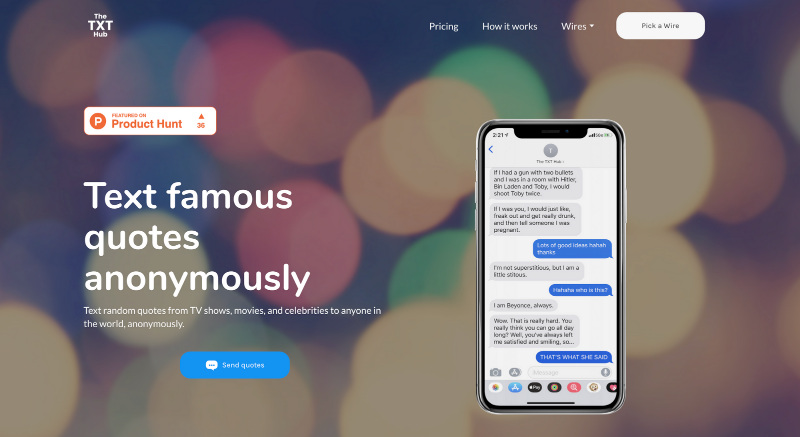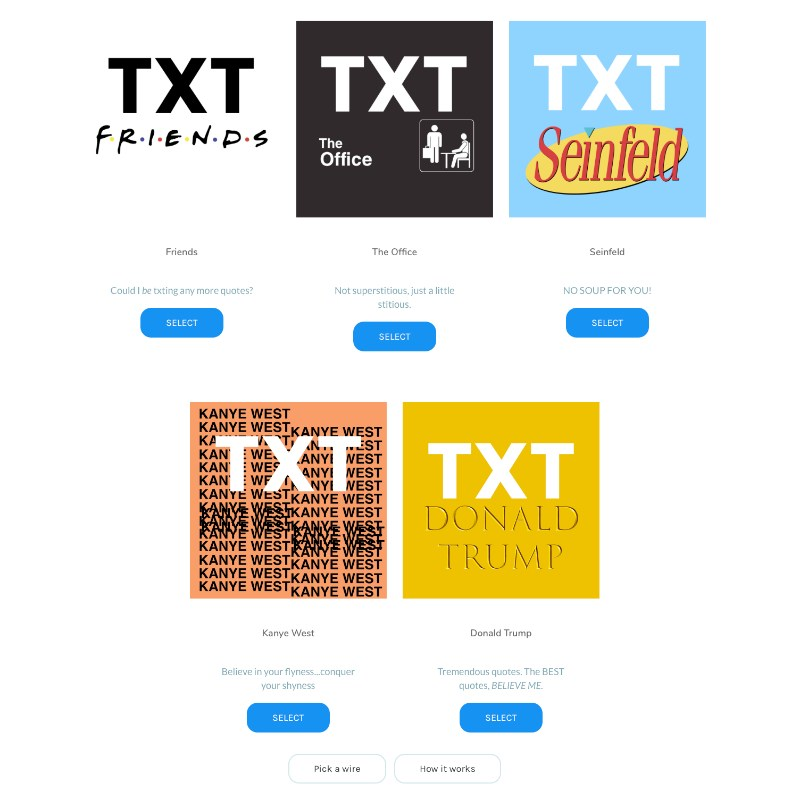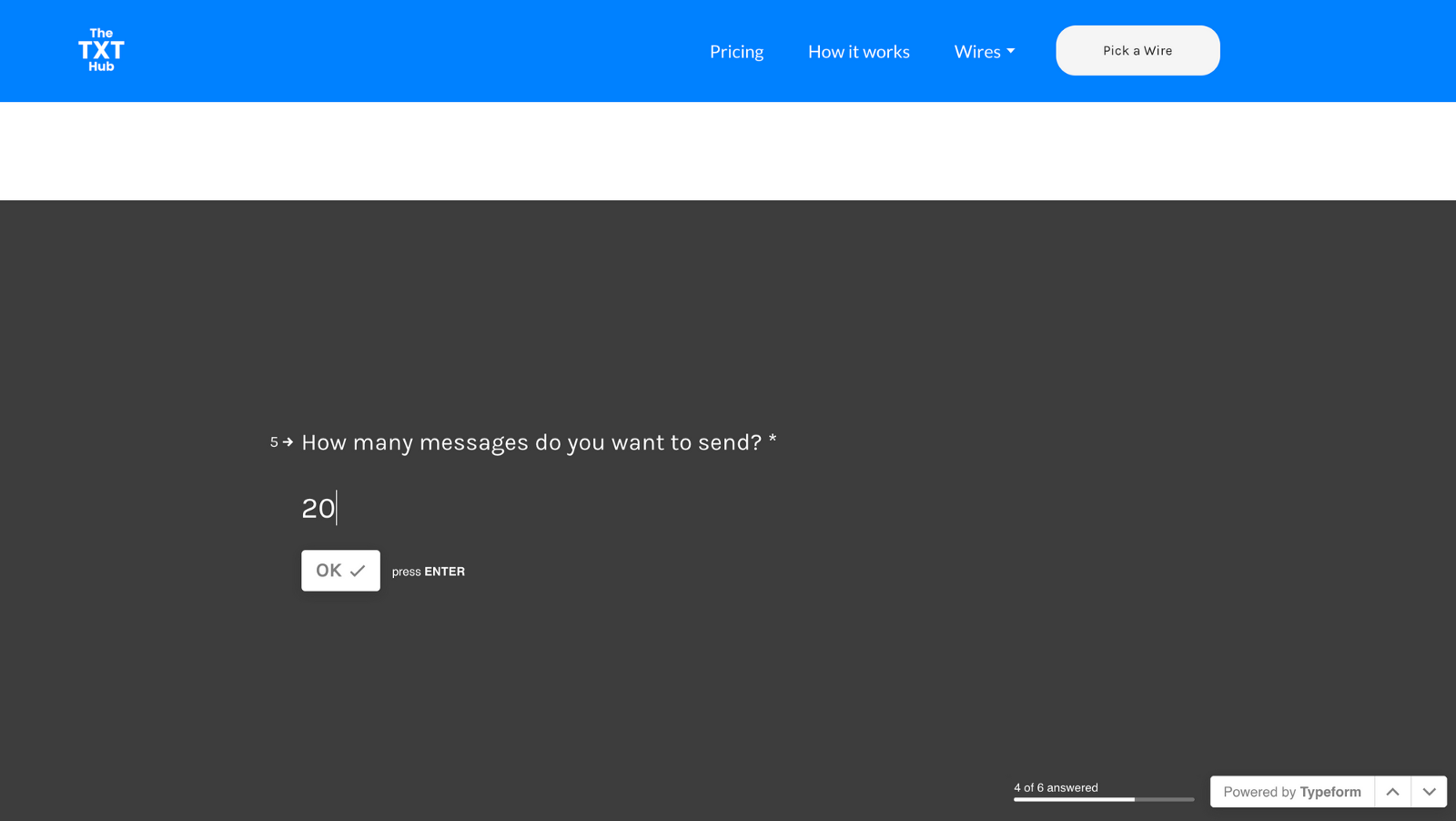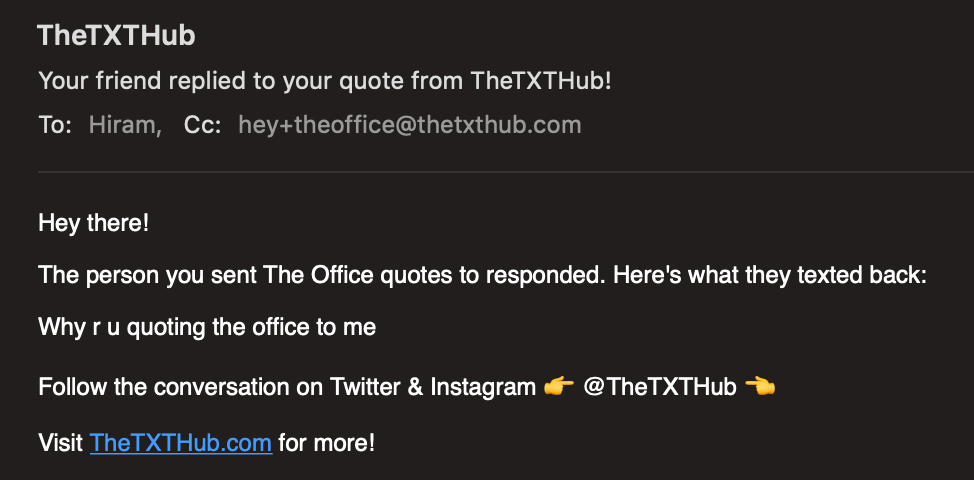Table of Contents
A short bio about your product/business:
What platforms and tools have you used to build The TXT Hub? How long did it take to build?
How have you gone about growing your user base? What has been most effective?
Have you monetized it yet? If so, what is your revenue model?
What has been the hardest part of building, growing or monetizing The TXT Hub?
Do you have any tips on building, growing or monetizing a no-code product/business?
Where can we find out more about The TXT Hub and connect with you?
A short bio about your product/business:
The TXT Hub is a texting app allows you to text famous quotes from celebrities and TV shows—anonymously.
Here's how it works:
- Pick a Wire (celebrity/TV show)
- Choose how many messages to send
- Enjoy
Your friend/family member/colleague will start to receive random quotes from your selected Wire.
Hey! What are you working on and what led you to building with no code? Have you got any previous experience of building sites/apps?
The story of how I built The TXT Hub is not very typical. Though it's not "officially" my first no-code project (Tee Tweets being the first), it is the first product, or app, depending on how you define it.
It was spring of 2019, and Product Hunt was having their annual makers festival. That year, it happened to be no-code themed. The deadline came and went as I couldn't make the time to build something, so I was pretty disappointed in that.

Shortly after the Product Hunt competition finished, I got invited to join a virtual no-code community, who happened to be running a competition at the time. Although the prize wasn't a new computer and a golden kitty trophy like Product Hunt's was, it was something I valued highly nonetheless—a lifetime membership to MakerPad. In a way, I actually thought this was better for me, because I had been wanting to learn more about building without code.
With a little bit more time on my hands around this time, I decided to block out time to figure out
- What I was going to build
- How I was going to build it
Shopify is widely regarded as a no-code tool, but it's for eCommerce. I hadn't really done a deep dive into other no-code tools that existed. Especially if I wanted to build something like a texting or communications app.

I think this was the toughest part—figuring out what to build because I wasn't even sure what I could build. I was afraid that even if I came up with something, I was gonna get stuck regardless because I didn't know what roadblocks I would hit and when I would hit them.
This competition had a deadline too, and I had joined late. So I was short on time already.
Therefore, I decided to do less thinking and more doing. Must admit I do get caught in analysis paralysis myself, so I was constantly coaching myself and training my brain to not overthink too much and just keep trying to put the pieces together.
What platforms and tools have you used to build The TXT Hub? How long did it take to build?
Given the time crunch, I built it in about 2-3 weeks. But I did spend many more hours building it than I expected/wanted to. A lot of things went wrong while building it. A lot. The prophecy of those roadblocks and now knowing when I'd hit them came true. If it wasn't one issue, it was another five. It felt like a giant puzzle with 6 major pieces, each of which are composed of hundreds of other tiny pieces.
Tools used:
- Typeform
- Twilio
- Stripe
- Zapier
- Mailchimp
- Sheets
Process Flow
Get user info → Receive in Sheets → Trigger outbound SMS → Receive inbound SMS → Send email (optional) → Create tweet
All things considered, the process flow is quite simple.
However, putting it all together was quite a puzzle. I built everything independently before worrying about the integrations that this would require. This means that I built the website, the forms, and Google Sheets before putting the pieces together.
Typeform
This was probably the easiest tool to work with. However, it's Calculator feature is not the most intuitive and could use some work. It was quite limiting in how I could calculate the number of texts being sent times the price.

In order to set an initial price, the price had to be set using a separate question. That separate question then set the baseline price, and that baseline price would be multiplied by the number of messages that the user wants sent.
One of the nice (perhaps overlooked) features about Typeform is that you can give it some design flair. If you click around the different Wires offered, you'll notice that they're all on simple and on theme for that particular Wire:
- The Office: Black and white, like the logo
- Seinfeld: Bland, ties to "The show about nothing"
- FRIENDS: Colorful, like the logo
- Kanye West: Earth-tones only, like his Yeezy clothing line (mostly brown, muted colors)
- Donald Trump: Extravagant, golden, everything is "the best, believe me"
Weblium
Oddly enough, I came across Weblium on ProductHunt. It seemed quite intuitive and not too pricey, so I decided to give it a shot. Between Webflow, Wix, Squarespace, Weebly, and tons of other website makers, it's tough to stand out. From what I gathered, it's a fairly small team, so I also wanted to patronize them a bit and support to see what other kinds of features they had in store. As a solo-maker myself, I enjoy supporting others making products for all.
They have some pretty great templates, and the interfaces are quite intuitive. Because it's intuitive, this also means that it can be limiting in what you can do. I would compare it to Squarespace, though I enjoyed using Weblium more than Squarespace. In my opinion, Squarespace can be a bit more difficult to navigate.
The drag and drop is a breeze to use, and is really helpful when you change your mind about your website's design (something I do quite a bit).
You can duplicate across pages, which is an underrated feature.
The blocks are super helpful in order to get up and running quickly. Once again, you'll be limited in what you can do if you have a very specific vision of how your website (or specific block) should look, but unless your design specifications are wildly custom, Weblium's blocks are a great starting point. They even jog your memory in thinking about different layouts.
You can also hide blocks, which is very useful if you don't want to display blocks on the live site but you don't want to delete them entirely. I'm not sure what kind of SEO implications this has on the backend though, so if possible, I would suggest you delete any blocks not in use.
MailChimp
MailChimp is quite straightforward. It simply houses the names and emails of people who send the quotes off to their friends, family, and coworkers. Its only use is to store these audiences, and receive notifications if the recipient replies to one of TheTXTHub's texts.

As with any email service, the sender can opt out of receiving emails when the recipient responds.
Twilio
Twilio is the service that actually sends the SMS texts. It's a very advanced tool used by some of the biggest companies in the world to streamline their communications. It's far from a no-code tool—in fact, it was made specifically for developers. However, for the sake of this project, I only used basic functionalities that made this work.
All that was needed from Twilio was the "Programmable SMS" service. They also have voice, WhatsApp, and more. Didn't use any of those though.
Not much to say about Twilio, other than the fact that it's what sends/receives messages.
Google Sheets
I won't say too much about Google Sheets since most of us have worked in Sheets or at least know what it is, but basically this is where the information from Typeform gets stored in a structured way.
I want to point out that it's structured, because it's important to note—keeping templates and structure is key.
Stripe
Stripe is the simple gateway for accepting payments. Stripe actually has a built-in integration capability with Typeform, so if you use Typeform, you can use Stripe directly on the form. There's no need to set up Stripe separately (aside from creating a Stripe account) to begin accepting payments.
Zapier
Zapier is what integrates Typeform, Google Sheets, Twitter, MailChimp, and Twilio. The way the platform works is quite simple: You have a set of rules and commands that you can work with through different platforms.
Once everything else was set up, it was just a matter of tinkering with Zapier to create "Zaps" as they call them to do what you'd like to do. For example:
- Get information from Typeform
- Save it into Google Sheets
- Save email in MailChimp
Or
- Receive inbound text reply
- Create tweet with response
The specifics of each zap are not too important, since there are a few ways to achieve the same output. The important thing to note is that Zapier brings together all these platforms to create a cohesive workflow that outputs what you need.
How have you gone about growing your user base? What has been most effective?
Honestly, nothing. I built it, and it got hunted spontaneously on Product Hunt as I was planning the PH launch myself. So that got some people trying it out and text bombing their friends.
Growth is something that I've been thinking about a lot with The TXT Hub. It's a simple and easy-to-use app with virtually no maintenance costs. And as you scale, you can continue to add Wires and new features for very little.
It's a set-it-and-forget-it type of product that can generate a good amount of revenue on its own without doing much else, but between Tee Tweets, consulting, and other work I do, it's been very difficult to make the time to grow The TXT Hub.
In fact, I've been toying with the idea of possibly selling it. It would make a great product for someone who can focus on growing it, since it's already built and ready to send out an endless amount of funny quotes from The Office, Friends, Kanye, etc.
It also requires 0 hours a week to maintain, so for someone who can market this effectively and/or is maybe trying to get familiar with building with no-code, it's a great product/opportunity. I feel bad that I haven't had the time to grow it the way it should. (That's what she said.)
I actually have a list of improvements and implementations to add Wires, decrease costs, add new tools, create content for it, and more. The infrastructure is all laid out. So if someone can take it and run with it to bring it to a broader audience, I would be happy to see that happen.
Have you monetized it yet? If so, what is your revenue model?
It was monetized since day one. It boasts on the website as the simplest pricing on the planet: Only 50¢ per quote.
No subscriptions. No commitments. No hard feelings.
Just tons of fun.
What has been the hardest part of building, growing or monetizing The TXT Hub?
The toughest part in building was putting it all together. As I mentioned before, they were all like puzzle pieces to me. I'm building this one singular product, but using 5+ different products to make it work. So I just had no idea how I would make that work. The best way to overcome this is to start with the business processes and maybe building out some logic flows. "What's point A and what's point B? And how do I get there?"
That is what got me started thinking more logically—mapping out the need for inputs, which would come from a form. "Once those inputs are received, where do they go? Why do they need to go there? And then once they hit, what do I do with that information? Well, it should trigger a text. But it should also verify that payment was actually received." Things like that.
In terms of growing, it's just been about dedicating time towards it. Unfortunately, I haven't been able to give The TXT Hub the time it deserves. Putting out content, marketing it, and more to attract users.
It actually has very low friction when it comes to users, since there's no need to download anything or create an account. It's literally as simple as filling out a quick form. So this is something that is really beneficial should I decide to sell it, because there's no need to worry about downloads, installs, signups, or other metrics that more traditional apps might have.
Do you have any tips on building, growing or monetizing a no-code product/business?
Not everyone likes ads, but that's always a relatively low-cost, low-effort option provided you have eyeballs looking at your product. You can do sponsorships, paid posts and promotions, features, email lists, a ton of stuff. Just make sure it fits your product somehow. Don't run ads for the sake of running ads.
Product Hunt, for example, has a devoted community of users. They make money in a few different ways, one of those being sponsored products in the day's hunts. They also have sponsors in their daily newsletters.
Perhaps a subscription model option would work as well, say if you wanted to send X amount of quotes per month. For The TXT Hub, it makes the most sense to simply charge per text, with no minimums or maximums. If you want to send 10 quotes, you can do that. If you want to send 200 quotes, all the better.
The pricing model is simple, linear, and easy to understand.
Where can we find out more about The TXT Hub and connect with you?
For everything related to The TXT Hub:
- Website: thetxthub.com
- Twitter: @theTXThub
- Instagram: @theTXThub
Hiram from the Chi on the web:
- Web: hiram.io
- Rising Tide (blog): hiram.io/blog
- LinkedIn: @hiramfromthechi
- Twitter/X: @hiramfromthechi
- Medium: @hiramfromthechi
- Mastodon: @hiramfromthechi@mastodon.social

